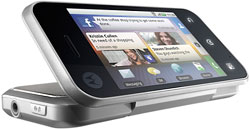
During its glory days in the 1990s, Motorola was the No. 1 mobile phone manufacturer in the world. Then Nokia overtook it, and ever since, Motorola has been trying to regain its lost footing. There was a glimmer of hope that it might be headed for a comeback in the mid-2000s with the success of the Razr. However, Motorola did not follow up with another winner, and its fortunes sank.
This week’s launch of the Backflip — a smartphone that comes on the heels of the well-received Droid and the Cliq — suggests Motorola is finally developing momentum.
The Backflip defies conventional smartphone design: When the handset is closed, the screen is on one side, and the QWERTY keyboard is on the other. When it’s open, the keyboard is positioned beneath the screen.
It features Motorola’s MotoBlur software — a platform that integrates social networking and other communications features easily for the user. MotoBlur also comes with the Cliq but not with the Droid.
It is likely AT&T will be the Backflip’s carrier, although that has not been confirmed. AT&T has announced it will offer five Android phones this year but has not said whether one of those will be the Backflip.
AT&T and Motorola did not respond to the E-Commerce Times’ requests for comment by this story’s deadline.
Moving Forward
With the Blackflip now out of the gate, Motorola’s star, it would seem, is fixed.
“Theoretically, three solid products should do wonders for Motorola,” agreed Greg Sterling, principal of Sterling Market Intelligence.
However, much depends on how well the Backflip actually does. Some of the buzz generated by the device is focused on how unusual its design is — and “unusual” doesn’t necessarily translate into rocket sales, suggested Patrick Gilbert, president and CEO of 4SmartPhone.
“I have doubts about the design — I don’t really understand the advantage of having that kind of layout compared to say, a clamshell, where the keyboard is protected, or a slide-out type of device,” he said.
“The layout is more of a novelty than based on any sort of practical use,” commented Sterling.
The design makes it easy to enjoy videos, music and photos, according to Motorola.
Despite his reservations, Gilbert acknowledged it would be premature to suggest that the design feature may detract from the company’s newfound handset creds. “In the past, Motorola fell down when it was perceived to be lagging in design or innovation. Say what you will about the Backflip — it is unique.”
It might even be better for Motorola to introduce a novel phone that doesn’t sell particularly well than to roll out another device that is only marginally different from those already on the market, he pointed out. “For Motorola’s comeback to be real, it needs to be seen as being aggressive in design and not just copying somebody else.”
Strength in Numbers
Motorola has pinned its hopes on the Android operating system, starting in September 2009 with the launch of the Cliq and Motoblur.
T-Mobile is the carrier for the Cliq, which is marketed as the “Dext” outside the U.S. A 3G phone with a 3.1-inch screen running on Android 1.5, the Cliq has a side slider keyboard. It’s equipped with a 5-megapixel autofocus camera that has picture editing and geotagging features, as well as video playback. It supports WiFi and Bluetooth 2.0 + EDR, and it comes with GPS.
While the Cliq was a head-turner, its debut didn’t compare to the splash the Droid made last November — thanks in large part to an aggressive marketing campaign by carrier Verizon Wireless.
The Droid debuted as the first Android 2.0 smartphone and the first Android phone for Verizon. It has a 3.7-inch touchscreen, a camcorder, a five-megapixel camera, a slide-out physical QWERTY keyboard, and very fast processing power. It also comes with 16 GB of storage.













































Social Media
See all Social Media